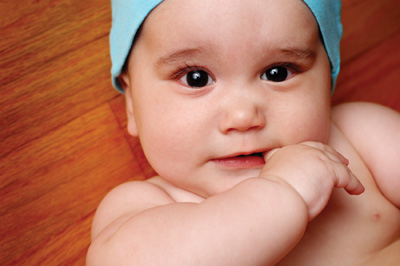Small chops
I can remember the day my son got his first […]
I can remember the day my son got his first tooth. I woke up that morning and elbowed my husband to get out of bed and check on our little guy. For the first time ever, he had slept the entire night through. “It’s a miracle!” I proclaimed. I was beaming all through my morning chores, thrilled that my 6-month-old had given me more than eight blissful hours of rest.
Then suddenly, out of nowhere and with a gust that would rival a category 5 hurricane, my slumber afterglow was stopped dead in its tracks by screams of pain from my little man. This wasn’t normal crying, but an intense sobbing that couldn’t be tamed by our usual calm-inducing techniques, though we tried them all. We walked. We talked. We bounced. We sang every verse of every song we could conjure up in our memories. Nothing seemed to stop his tears. I was about to head to the emergency room when I decided to check his gums. They looked swollen and as soon as I touched them, I could see my tiny man wince with pain and hear his wails grow louder.
I knew all at once that Mother Nature had given us one night of uninterrupted slumber in preparation for the battle to follow, what we now refer to as The Great Teething War of 2014. We didn’t sleep for four days.

But even if your child’s teeth make a happy and welcome debut, there’s still plenty of information you need to know. Read on to see what’s going on inside your tiny tot’s mouth and what you can do to help when teething commences.
Why, hello there
Baby starts forming teeth while he’s still in your womb, but you normally won’t notice the appearance of those teeth until baby’s half birthday. Although most babies begin teething around 6 months, “There’s a wide range of variability,” advises Kaneta R. Lott, DDS, board-certified pediatric dentist and consultant to the Georgia Board of Dentistry and the American Dental Association. For example, “Some babies will start to teethe in their first 30 days of life,” she says. “Those teeth are called neonatal teeth.” On the flip side, there are also late teethers, whom Lott shares won’t sprout a tooth until 12 to 18 months of age. As long as your baby falls somewhere within the normal range, there isn’t need for worry. “Most babies will get 10 teeth on top and 10 teeth on bottom and will get their last molar between 24 and 36 months,” says Lott, who notes there may be up to a six-month variance. “I don’t get alarmed if a baby doesn’t have all his teeth until 36 months; after 36 months is when I get concerned,” she adds.
On the lookout
Since a baby, especially one in daycare or with siblings, is prone to catching several ailments at a time, you may find it hard to distinguish between a common cold and teething. “Somewhere around 4 months, children start putting everything in their mouths, [but that alone] usually doesn’t mean they’re teething,” say Lott. Nor does drooling: It may just mean the muscles aren’t yet strong enough to hold in the drool, she explains. But around 6 months, drooling will signal teething. Other symptoms to look out for include swollen gums, fussiness, a runny nose, a rash (usually caused from the irritation of wiping the saliva), biting and sucking. “The difference between a cold and teething is the temperature. If a child spikes a fever and the fever is over 100°F, seek a pediatrician’s advice because it’s probably not related to teething,” adds Lott.
Gnaw on this
Thankfully, Lott says there are things you can do to relieve the pain your baby is feeling. “Any time there is a nice, gentle pressure, it feels good for baby. When baby is teething, the gums itch. That’s why teething rings help. The cool temperature and raised bumps rub the gums and it feels nice,” says Lott, who also recommends using a pasty, thick gel that stays in place on the gum. With liquid gel, she advises being mindful of whether the liquid runs off, numbing the back of the throat. This, she advises, can result in choking hazards. Her favorite remedy, however, is an old-fashioned technique that she believes is the best way to calm achy gums. Take a wet washcloth and put your finger inside the cloth. Then, hold your baby and let your baby chew on your finger. You are able to hold and cuddle and baby is able to contently bite on the cloth. “The softness of the mother’s finger gives just enough bounce to soothe the gums,” says Lott.
Bite maintenance
Though you may feel like you’ve tackled the teething hurdle, you’ll want to make sure to start healthy care habits early. The American Academy of Pediatric Dentistry (AAPD) recommends that each child visit the dentist when they are 1 year old or six months after the first tooth appears in the mouth. And Lott advises that it’s not as easy picking a dentist as you might think. “Always ask if your dentist is a pediatric dentist,” she says. Why? “Pediatric dentists have had two or three years of residency over and above that of regular dental school,” says Lott, who continues, “This means they don’t just choose to treat children, but instead they’ve specialized in treating children out in the field.” Pediatric dentists can also treat persons with mental and physical disabilities, people who are in the hospital for medical concerns, and children who need surgery in the operating room. They are trained in child psychology and psychology with the family. “It’s not a matter of just hanging on a shingle,” says Lott, “we have dedicated our lives to treating children and most don’t treat adults.”
It’s also important to make dental care a daily occurrence in your family. As soon as your baby’s teeth appear, begin cleaning them with a washcloth at least twice a day until your tot is old enough to use a baby toothbrush. Also, try to avoid letting your baby fall asleep with a bottle or sippy cup of milk as this may cause the teeth to decay at a faster rate. And of course, practicing good dental health yourself will allow your child to mimic healthy practices for the future.
While I wish there were a magic serum I could pass your way to instantly make the pain of teething disappear, the truth is, you already come equipped with everything you need to handle it. A generous dose of patience and some tender love and care is all it will take to help your baby’s smile shine through.







